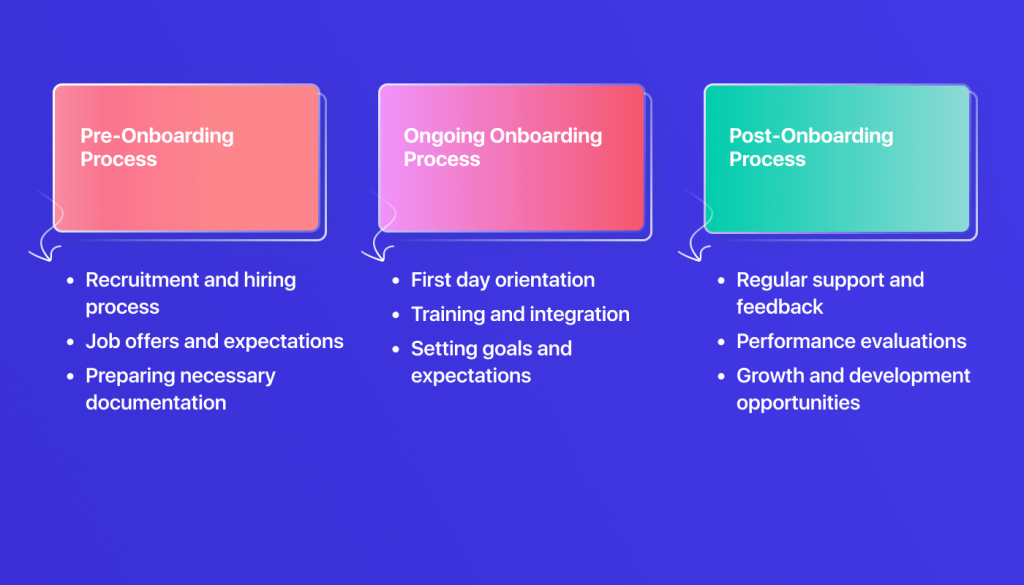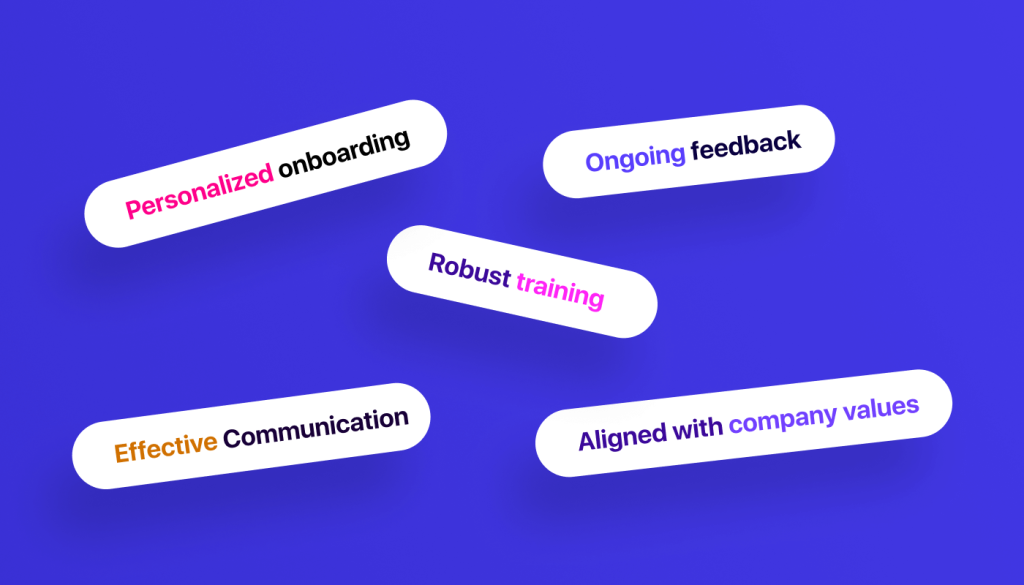What is Employee Onboarding: Insights for HR Professionals

The onboarding process establishes the foundation for an employee’s journey within an organization. Understanding its importance and implementing effective strategies can significantly impact employee retention, productivity, and overall organizational success.
However, it’s often overlooked or undervalued due to several reasons including lack of awareness, time, cost, awareness, short-term focus, etc.
In this write-up, I’ll discuss what employee onboarding is, its purposes, phases, best practices, and many more to help HR professionals improve this crucial process.
What is Employee Onboarding?

Employee onboarding is the process of integrating new hires into the organization. This strategic process extends beyond mere paperwork and orientation sessions. It’s designed to immerse employees into the company’s culture, policies, and procedures to succeed in their roles.
Employee onboarding also involves familiarizing fresh recruits with company goals, and values. At the same time, introduced them to their team members and key stakeholders.
Types of Employee Onboarding
Structured employee onboarding can increase 60% of company revenue ~ Research by Northpass !💰
Every organization aims to create a space for growth and innovation. They always try to refine their onboarding approach to match their unique culture and goals.
Usually, there are 7 common categories of employee onboarding such as
1. Operational Onboarding
- Completion of HR paperwork (e.g. contracts, benefits enrollment).
- Issuance of access badges, email accounts, and necessary equipment.
- Workplace introduction including facilities, locations of restrooms, break areas, and emergency exits.
2. Knowledge Onboarding
- Training sessions on company policies, procedures, and compliance requirements.
- Orientation on specific job roles, responsibilities, and expectations.
- Access to online resources and manuals for reference and self-learning.
3. Performance Onboarding
- Setting up performance goals and milestones for the initial probationary period.
- Regular feedback sessions to track progress and address any issues early on.
- Introduction to performance evaluation systems and criteria.
4. Talent Onboarding
- Identification of individual strengths and areas for development through assessments.
- Enrollment in skill development programs, workshops, or mentorship initiatives.
- Opportunities for cross-training or job shadowing to broaden skill sets.
5. Social Onboarding
- Introduction to team members, department heads, and key stakeholders.
- Participation in team-building activities, such as lunches, outings, or virtual meetups.
- Integration into company culture through involvement in employee resource groups or social events.
6. Strategic Process Onboarding
- Briefing on the company’s mission, vision, and core values.
- Explanation of the organization’s long-term goals and strategic initiatives.
- Alignment of individual tasks and projects with broader organizational objectives.
7. Organizational Process Onboarding
- Familiarization with internal communication channels, such as email, chat platforms, and project management tools.
- Training on specific workflow processes, such as expense reporting, time tracking, or project approvals.
- Understanding of departmental structures, reporting hierarchies, and escalation procedures.
Purposes of Employee Onboarding
Employee onboarding is a critical process for any organization. The primary purposes of employee onboarding include:
Cultivating a Positive Company Culture
Onboarding is an opportunity to introduce new employees to the company’s values, mission, and culture. This helps them to match the organization’s goals and behaviors.
Accelerating Time to Productivity
The onboarding process guides employees with the necessary knowledge, skills, and resources. As a result, new employees become productive contributors to the organization more quickly.
Building Stronger Employee Engagement
By welcoming new hires, organizations can grow a sense of belonging and commitment among employees. Plus, a comprehensive onboarding process brings in higher levels of engagement and job satisfaction.
Enhancing Knowledge Transfer
Onboarding facilitates the transfer of knowledge and expertise from existing employees to newly appointed staff. This strategic approach ensures the dynamic passing of valuable institutional knowledge among all employees gradually.
Boosting Employee Satisfaction and Retention
Organizations with robust employee onboarding processes can boost retention rates by 82%. ~ Brandon Hall Group’s report
A well-planned and executed onboarding process can significantly impact employee satisfaction and retention rates. It provides new employees with the guidance and resources they need to feel valued by the employer.
Note: Employee onboarding phases can take various forms. It can be virtual, traditional in-office with paper documentation, or in a simplified digital format.
Phases in the Employee Onboarding Process

Employee onboarding is not just a one-time event; it’s an ongoing process with multiple phases and activities.
According to Sapling reports, a new hire faces 50+ activities such as paperwork, orientation, administration tasks, etc.
Let’s explore the major 3 phases including the activities in employee onboarding.
1. Pre-onboarding Process
The preboarding or pre-onboarding phase begins as soon as a job offer is accepted and includes activities. This phase involves
✅ Recruitment and Hiring Process
- Conducting interviews to assess candidates’ qualifications and fit for the role.
- Evaluating resumes, portfolios, and references to determine candidate suitability.
- Collaborating with hiring managers and team members to make informed hiring decisions.
✅ Communicating Job Offers and Expectations
- Extending job offers to selected candidates, including details on salary, benefits, and start date.
- Clarifying job expectations, responsibilities, and performance metrics to ensure alignment.
- Addressing any questions or concerns from the candidate regarding the offer or role.
- Sending a detailed first-day email containing schedules, addresses, and other relevant information.
✅ Preparing Necessary Documentation
- Compiling and organizing paperwork required for onboarding, such as employment contracts, tax forms, and confidentiality agreements.
- Reviewing and updating company policies, employee handbooks, and compliance documents as necessary.
- Ensuring all legal and administrative requirements are met to facilitate a smooth onboarding process.
2. Ongoing Onboarding Process
Most of the companies refer to the ongoing onboarding phase as the entire employee onboarding process. However, this phase typically indicates the first few weeks or months of employment.
In the employee’s ongoing onboarding phase, human resources or employers should conduct the following activities:
✅ New Hire Orientation (First Day)
- Welcoming new hires, and providing a tour of the workplace to familiarize them with key areas.
- Introducing new members to team members, managers, and key stakeholders.
- Providing an overview of company policies, culture, values, and mission to establish alignment.
- Distributing essential materials such as employee handbooks, organizational charts, and company swag.
✅ Training
- Conducting job-specific training sessions to equip fresh recruits with the knowledge and skills required for their roles.
- Offering on-the-job training opportunities to facilitate hands-on learning and practical application.
- Providing access to learning resources, online training modules, and educational materials to support ongoing development.
✅ Integration
- Facilitating onboarding of HR software for team building activities, group projects, or social events for collaboration.
- Pairing new employees with mentors or buddies to provide guidance, managerial support, and assistance in navigating the organization.
- Encouraging participation in cross-functional meetings, departmental events, and company-wide initiatives to promote integration.
✅ Setting Goals and Expectations
- Setting clear performance expectations, objectives, and KPIs aligned with the new hire’s role and responsibilities.
- Conducting goal-setting meetings to discuss individual goals, career aspirations, and development plans.
- Providing regular feedback, performance reviews, and coaching sessions to track progress and ensure alignment with organizational goals.
3. Post-onboarding Process
15% of companies extend their onboarding process more than six months ~ Ben Peterson, CEO of BambooHR
Post-onboarding or postboarding provides ongoing support, feedback, performance evaluations, and growth opportunities after the initial onboarding and probation period.
✅ Regular Support and Feedback
- Providing ongoing support and guidance to new hires as they acclimate to their roles and responsibilities.
- Conduct regular check-ins and one-on-one meetings to address challenges, questions, or concerns.
- Offering constructive feedback, praise, and recognition encourages continuous improvement and engagement.
✅ Performance Evaluations
- Conducting periodic performance evaluations to assess progress, achievements, and areas for development.
- Reviewing performance metrics, KPIs, and goals to measure individual and team performance.
- Providing actionable feedback and development plans to enhance performance and address performance gaps.
✅ Opportunities for Growth and Development
- Identifying opportunities for skill enhancement, career advancement, and professional development.
- Offering access to training programs, workshops, seminars, and educational resources to support ongoing learning.
- Encouraging participation in internal mobility programs, cross-functional projects, and leadership development initiatives for career progression.
Help – Make Onboarding Easy: Top 5 Free HR Onboarding Software
Best Practices for Employee Onboarding

Exploring employee onboarding offers transformative experiences for both organizations and new team members. Follow the following best practices to ensure efficient, consistent, and engaging processes, fostering productivity, compliance, and satisfaction.
🔷 Personalized Onboarding Experience
Conduct onboarding for each employee’s role, experience, and needs. Google’s onboarding process includes a “Noogler” orientation program is a perfect example of that. It consists of tech setup, culture sessions, and receiving the Noogler cap and other orientation materials. The Noogler onboarding program lasts for one to two weeks.
Personalized onboarding helps new employees to integrate into the company culture and understand their roles more effectively.
🔷 Clear Communication and Feedback Channels
Provide open lines of communication and regular feedback mechanisms to address any questions or concerns new hires may have. This can include regular check-ins with managers, anonymous feedback surveys, accessible HR support, etc.
🔷 Comprehensive Training and Development Opportunities
Offer robust training programs and ongoing development opportunities to help employees grow in their roles. This could involve workshops, online courses, mentorship programs, and so on!
🔷 Continuous Improvement and Evaluation of The Process
Regularly assess and refine the onboarding process based on feedback and outcomes to ensure its effectiveness. This may involve soliciting input from both new hires and managers, analyzing retention rates, and adjusting procedures as needed.
🔷 Integration of Company Values and Mission
Incorporating company values and mission into every aspect of the onboarding process, such as aligning team-building activities with core values. Plus, Sharing success stories that exemplify the company’s mission to inspire new employees.
FAQs
What are the 5 Cs of employee onboarding?
The 5 Cs of employee onboarding are compliance, clarification, culture, connections, and checkback. They represent key aspects including ensuring legal compliance, clarifying job roles, introducing company culture, fostering connections with colleagues, and providing ongoing support and feedback.
What is the role of HR in the onboarding process?
HR’s role in onboarding includes overseeing paperwork completion, conducting orientation sessions, coordinating training programs, supporting new hires, and ensuring compliance with legal and company regulations.
What is the biggest challenge of onboarding?
The biggest challenge of onboarding is often the lack of a structured process. Approximately 2 in 3 employers don’t have a formalized onboarding system in place, leading to inconsistencies and gaps in the new hire experience.
What is the opposite of onboarding an employee?
The opposite of onboarding an employee is offboarding or employee separation. Offboarding involves the process of transitioning an employee out of the organization due to resignation, termination, retirement, or other reasons.
How long does the onboarding process take?
The onboarding process typically takes at least three months for new hires. However, it extends throughout the employee’s first year for a comprehensive integration.
What is the average cost of onboarding?
The average cost of onboarding varies depending on factors like company size and industry. However, estimates suggest it can range from a few hundred to several thousand dollars per employee.
What is the checklist for new employees?
A new employee checklist typically includes tasks such as completing HR paperwork, attending orientation sessions, receiving necessary training, obtaining equipment and access credentials, meeting team members, and setting goals with managers.
1 Comments
[…] hire and onboard candidates who can be the right fit for your company to create a healthy work […]